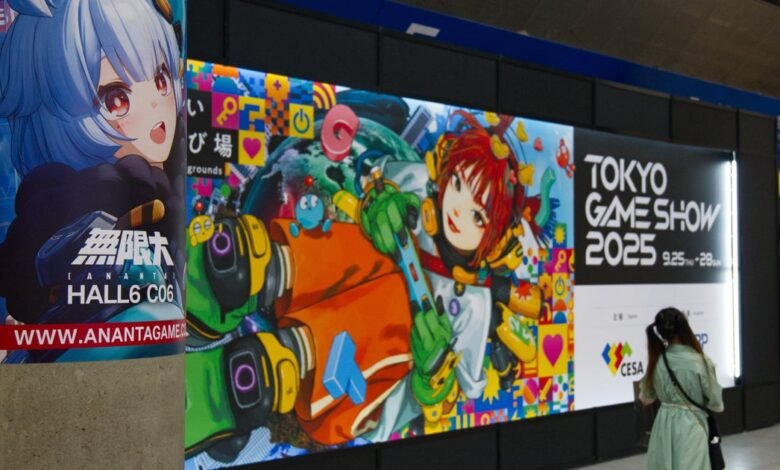Behind the Glitz: Tokyo Game Show’s Economic Anxieties

▼ Summary
– Major Japanese publishers showcased few new games at TGS 2025, focusing instead on already released titles or those launching soon.
– Free-to-play mobile games dominated the event with flashy booths and attracted large crowds, filling the void left by traditional console and PC showcases.
– The Japanese gaming market is shifting, with mobile gaming driving industry growth while the console market has shrunk since 2020.
– Economic pressures and high console costs are leading players to prefer free-to-play games, which offer high-budget experiences without expensive hardware.
– The event highlighted industry anxieties, including budget cuts, game cancellations, and the rise of generative AI and exploitative marketing tactics.
The Tokyo Game Show 2025 revealed a gaming industry at a crossroads, where established Japanese console giants scaled back their presence while free-to-play titles dominated the show floor with aggressive marketing and immersive fan experiences. This year’s event felt markedly different from previous editions, with many major publishers like Sega, Konami, and Level-5 showcasing games either already available or scheduled for imminent release. Sega highlighted Sonic Racing: Crossworlds, which launched the same day as the show, and the freshly announced Like a Dragon 3: Kiwami. Konami focused on the domestic hit Momotaru Densetsu and the previously released Silent Hill f.
Level-5 returned with Inazuma Eleven: Victory Road and Professor Layton and the New World of Steam, both previously featured in 2024, while absent were anticipated titles like Decapolice, now delayed to 2026. Sony, Square Enix, and Bandai Namco followed a similar pattern, emphasizing autumnal releases for series like Digimon and Little Nightmares. Capcom stood out as the sole major draw for console and PC enthusiasts, presenting early domestic looks at its 2026 lineup, including Resident Evil: Requiem and Pragmata.
So where did the excitement go? The answer lies beyond the convention center. Akihabara, once the undisputed heart of Japanese gaming and anime culture, now features billboards dominated by overseas free-to-play hits like Genshin Impact. Animate Akihabara’s entrance promotes a Nikke and Resident Evil collaboration, while Akihabara Station’s central exit has been renamed for Yostar, the Shanghai-based company behind Azur Lane and Blue Archive.
Mobile gaming continues to command a staggering share of Japan’s gaming revenue, with in-app purchases hitting $11 billion in 2024 according to Sensor Tower. The free-to-play sector has matured, making it incredibly difficult for new titles to compete with established favorites without significant marketing investment. Events like TGS offer a high-profile, but expensive, platform for visibility, with booth costs ranging from ¥385,000 for a small space to millions for larger installations.
A preview of the 2025 CESA Video Game Industry Report highlighted a 3.4% growth in the Japanese games industry to ¥2,396 billion, driven almost entirely by mobile. Console revenue shrank from ¥395 billion in 2020 to ¥383 billion, while the PC market more than doubled to ¥265 billion. Demographically, mobile gaming matches or exceeds console play across all age groups from five to sixty, with the Nintendo Switch remaining the most common primary or secondary device. The PS5, priced at ¥80,000, struggles to attract younger players compared to the more affordable Switch 2 at ¥50,000.
Free-to-play publishers seized the opportunity at TGS, deploying flashy booths, live models, and exclusive merchandise to capture fan attention. Titles like Love and Deepspace, Infinity Nikki, and Nikke drew large crowds eager for photo opportunities and collectibles. Among unreleased games, Ananta, an open-world action title from Naked Rain and NetEase, garnered consistent queues and positive demo feedback, despite noted similarities to popular Western games. Other free-to-play standouts included Miresi: Invisible Future from Smilegate and NetEase’s Sword of Justice.
Several factors explain the resurgence of free-to-play in Japan’s post-pandemic economy. Although mobile games attract lower per-user spending than console or PC titles, revenue is sustained by a small group of high spenders. A recent survey found that 18.8% of respondents prioritized gacha spending over essentials like rent. At the same time, many players engage without spending at all, drawn in by high production values and accessible gameplay.
Persistent economic pressures, including stagnant wages and a 100% increase in the price of rice over twelve months, have made luxury purchases like new consoles and premium games less feasible. Free-to-play titles provide an affordable entry point, supplemented by merchandise, pop-up cafes, and real-world events that transform gaming into a lifestyle. For those avoiding in-game purchases, character goods and social activities offer alternative ways to participate in the hobby.
Marketing tactics at TGS grew increasingly provocative, with several booths employing sexualized imagery and gimmicks to attract big spenders. For the second year, Nikke featured a “human gacha” where players pressed a button to reveal cosplayers in boxes mimicking the game’s reward screen. Nearby, Miresi: Invisible Future drew attention with a 5.5-meter LED cube displaying exaggerated animations of its protagonist. These approaches, while controversial, aim to captivate the niche audience most likely to fund these games through microtransactions.
Behind the scenes, 51% of Japanese developers reported adopting generative AI according to the same industry report, a move aimed at cutting costs amid tightened budgets. A dedicated AI pavilion at TGS underscored this shift, though it also pushed indie game exhibits into less visible corridors, a symbolic demotion of creative work. Meanwhile, layoffs in Japan remain less common than abroad, but many studios are opting not to renew temporary contracts rather than dismiss full-time staff.
This year’s TGS cannot be dismissed as a temporary correction. It reflects a decade-long trend of economic strain, pushing players toward free-to-play models and forcing developers to rethink production and promotion. The growing respect for Japanese games internationally contrasts with domestic realities, where industry and player anxieties overshadow traditional showcases of innovation and artistry. Addressing these challenges will require broader economic solutions, as the issues extend far beyond gaming itself. While TGS 2025 offered no clear answers, it unmistakably signaled the direction in which the industry is moving.
(Source: Games Industry)





